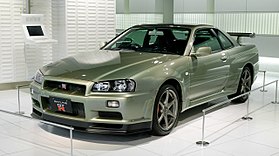R33
| R33 | |
|---|---|
 |
|
| Overview | |
| Production | 1993–1998 217,133 units sold |
| Assembly | Musashimurayama, Japan |
| Designer | Kozo Watanabe (1991) |
| Body and chassis | |
| Body style | 4-door sedan 2-door coupe |
| Layout | Front engine, rear-wheel drive / four-wheel drive |
| Related | Nissan Laurel Nissan Stagea |
| Powertrain | |
| Engine | 2.0 L RB20E I6 (GTS) 2.5 L RB25DE I6 (GTS-25, GTS-4) 2.5 L RB25DET Turbocharged I6 (GTS-25T, GTS-T) 2.6 L RB26DETT I6 Twin Turbocharged (GT-R) 2.8 L RBX-GT2 I6 Twin Turbocharged (400R) |
| Transmission | 4-speed automatic 5-speed manual 5-speed automatic |
| Dimensions | |
| Wheelbase | 2,720 mm (107.1 in) |
| Length | 4,720 mm (185.8 in) (sedan) |
| Width | 1,720 mm (67.7 in) |
| Height | 1,360 mm (53.5 in) (sedan) |
| Curb weight | 1,390 kg (3,064.4 lb) (GTS-25t) 1,530 kg (3,373.1 lb) (GT-R) |
1993–1996 Nissan Skyline (R33) GTS25t coupe
Some models came equipped with a new version of the HICAS 4-wheel steering system called Super HICAS. This computer controlled system was first used on the R32 GT-R. Super HICAS used electric actuators to steer the rear, as opposed to the hydraulic HICAS. This generation was no longer considered a "compact" under Japanese legislation that determined the amount of tax liability based on exterior dimensions.
As an option, an active limited slip differential was available instead of the standard viscous LSD. This new unit locked the rear differential if it detected that traction was lost by one of the wheels. A light on the dash also lit up if the LSD engaged. Active LSD came standard on all V-Spec R33 GT-R Skylines and was also available on some ECR33 GTS-25t models; these can be identified by the A-LSD and SLIP lights on the tachometer.
The RB25DE and RB25DET engines also became equipped with NVCS (variable inlet cam phasing). NVCS equipped RBs have a bulge on the front of the cam cover. To celebrate their 40th anniversary, Nissan introduced a very rare 4-door GT-R. Two versions of the 4-door GT-R were available from Nissan's subsidiaries: the first was produced by Autech, and the second was a joint Autech/Nismo project.
A Nissan Laurel C34 based wagon was released in September 1996, called the Stagea. It is widely regarded as a compatriot of the Skyline, rather than the Laurel it was based on, owing to drivetrain configurations—Commonly AWD using ATTESA ET-S. A common modification on the Stagea is to fit it with an R34 skyline front, in effect making an R34-lookalike wagon. A manual transmission was only available on the RS-Four and RS-Four V models. There was also an Autech tuned Stagea, the 260RS; released with full GT-R running gear, including an RB26DETT engine and manual transmission, a unique body kit, 17" BBS style alloys, and GT-R instrumentation.[34]
Models:
- HR33 GTS – 2.0 L RB20E SOHC I6, 130 PS (96 kW, 172 N m)
- ER33 GTS-25 – 2.5 L RB25DE DOHC I6, 190 PS (140 kW, 231 N m)
- ENR33 GTS-4 – 2.5 L RB25DE DOHC I6, 190 PS (140 kW, 231 N m) 4WD
- ECR33 GTS-25t (GTS-t) – 2.5 L RB25DET DOHC turbo I6, 250 PS (184 kW, 294 N m)
- ECR33 P.Ride 280 Type MR – 2.8L RB28DETT DOHC turbo I6, 300 PS
1996
R33 GTST series 2 with a R33 GT-R Bumper and East Bear carbon fibre bonnet
GT-R
1993–1996 Nissan Skyline (R33) GTS (base model). Known because of the 4 stud hubs
R33 Skyline interior
A limited edition model was created in 1996, called the NISMO 400R, that produced 400 hp (298 kW) from a road-tuned version of Nissan's Le Mans engine.[36] A stronger six-speed Getrag gearbox was used.
An R33 GT-R driven by Dirk Schoysman lapped the Nordschleife in less than 8 minutes. Though it was often said to be the first production car to break 8 minutes, the limited run Jaguar XJ220 had already achieved a 7'46" lap.[37] Other manufacturers had caught up since the R32 was released, and the R33 never dominated motorsport to the extent of the R32.
Models:
- GT-R – 2.6 L RB26DETT DOHC twin-turbo I6, 305 PS (224 kW, 375 N m) (advertised as 280 PS) 4WD
- GT-R LM – 2.6 L RB26DETT DOHC twin-turbo I6, 305 PS (224 kW) FR
- NISMO 400R – 2.8 L RBX-GT2 DOHC twin-turbo I6, 400 PS (294 kW, 478 N m) 4WD
- 4Dr.GT-R Autech Version – 2.6 L RB26DETT DOHC twin-turbo I6, 305 PS (224 kW, 375 N m) (advertised as 280 PS) 4WD - only 447 made[25]








